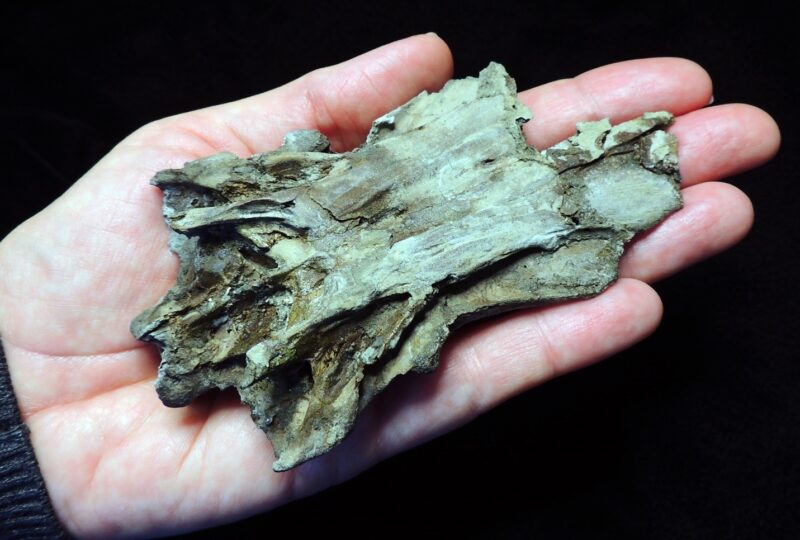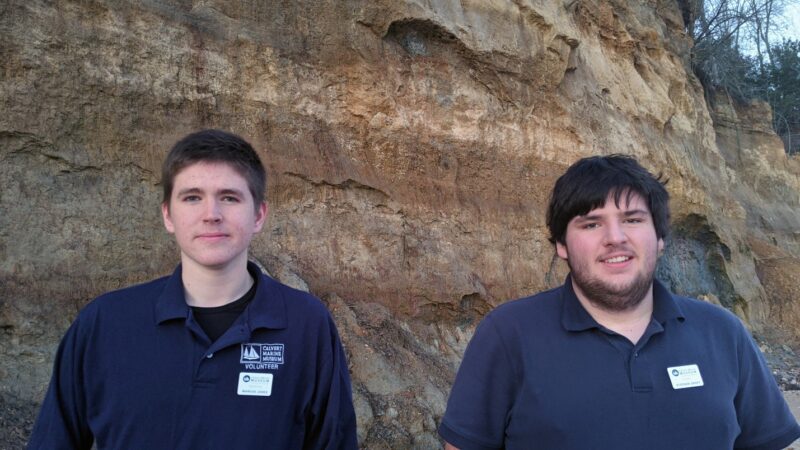 On April 27, 2019, local fossil enthusiasts Stephen Groff and Marcus Jones found a partial skull of a fossil fish along Calvert Cliffs. Little did they know at the time that it would turn out to be the find of a lifetime.
On April 27, 2019, local fossil enthusiasts Stephen Groff and Marcus Jones found a partial skull of a fossil fish along Calvert Cliffs. Little did they know at the time that it would turn out to be the find of a lifetime.
Using a microscope, needles, and fine brushes, Groff carefully removed the entombing sediments from around the 10 million-year-old bones to reveal a true treasure. This fossil-find consisted of the bony braincase of a cobia – the first ever found in the fossil record. The only known species of living cobia is a marine inhabitant that occurs nearly worldwide in a variety of tropical, subtropical, and warm temperate habitats and occasionally enter estuaries, feeding on crustaceans, cephalopods (squid and their kin), and other fishes. The hand-sized fossilized partial skull was different enough from the living cobia that a new species was named in honor of Groff and Jones, and published recently in the Journal of Paleontology.
Calvert Marine Museum Curator of Paleontology Dr. Stephen Godfrey, along with fossil-fish expert Dr. Giorgio Carnevale of Torino, Italy, named the new species of cobia Rachycentron stremphaencus. When paleontologists describe a new fossil species, one of the perks is that they get to invent a new name for the new species – and they can name it just about anything they like! In this situation, it seemed most fitting to name it after the co-discoverers. So, the new species name “stremphaencus” is derived from a combination of the letters of “Stephen” and “Marcus” with some rearrangement of the letters to make it mellifluous.
Up until now, no species of cobia had ever been named in the fossil record, so this is a first, and big news for paleontologists, both amateur and professional. When asked about the find, Jones said, “It’s a privilege to be able to participate in such an exciting field.”
Groff and Jones found the braincase in a block of sediment that had fallen onto the beach from the adjacent cliff face. When asked about the find, Groff responded, “It wasn’t until the next day when I returned with Calvert Marine Museum Paleontology Collections Manager John Nance to collect the specimen, that we realized it was a skull, and it was then that I knew this was going to be something special.
A word of warning! Digging in the cliffs is dangerous and is prohibited without a permit on all state and federal lands. On private land, permission must be obtained from the owners before digging. If you see a skull, bone, or unusual fossil in the cliffs, please report it to the Calvert Marine Museum at 410-326-2042. The museum appreciates getting this information and, if justified by the importance of the find, will make every effort to obtain the necessary permission and have trained personnel collect the specimen, giving full credit to the finder(s).
The clay and sandy sediments in which the fossil was found indicate that the prehistoric environment was a shallow marine one, perhaps even an estuary similar to the present-day Chesapeake Bay. (The Chesapeake Bay as we know it did not exist 10 million years ago.) A large number of predominantly marine species have been found in these deposits, with representatives from several groups of microscopic fossils and invertebrates, like snails and clams, as well as an array of vertebrate species, including a host of sharks and rays, bony fishes, turtles, crocodiles, sea-faring birds, seals, sea cows, dolphins, and baleen whales, and the very rare remains of large terrestrial mammals like extinct elephants and rhinos.
Based on the ecological requirements of the only living species of cobia, and a reconstruction of the environmental conditions that existed when the fossil cobia was alive 10 million years ago, it is reasonable to conclude that Rachycentron stremphaencus was a predatory fish that inhabited the subtropical to warm temperate Atlantic coast of North America during the Late Miocene, where it lived and hunted in shallow marine waters. Inspired by their recent contribution to the world of paleontology, Groff and Jones continue to hunt for fossils along the shores of the Chesapeake Bay.





